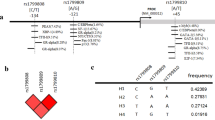Abstract
Previous genetic and epidemiological studies have shown the contribution of genetic factors in conferring the risk of ischemic stroke. Among the acknowledged risk factors of stroke are the single nucleotide polymorphisms (SNPs) near Ninjurin 2 (NINJ2) gene which encodes a surface adhesion protein. In the current study, we investigated the role of two SNPs near this gene in ischemic stroke in Iranian population. The frequency of the A allele of the rs11833579 was significantly lower in cases compared with controls (OR (95% CI) = 0.68 (0.54–0.86), adjusted P value = 0.002). The rs11833579 was significantly associated with risk of stroke in co-dominant (AA vs. GG: OR (95% CI) = 0.39 (0.23–0.66), adjusted P value = 0.003) and recessive (OR (95% CI) = 0.44 (0.27–0.72), adjusted P value = 0.001) models. The rs3809263 was associated with risk of stroke in dominant model (OR (95% CI) = 1.5 (1.09–2.06), adjusted P value = 0.02). The A C haplotype (rs11833579 and rs3809263) decreased the risk of stroke (OR (95% CI) = 0.72 (0.57–0.91), adjusted P value = 0.03), while the G T haplotype conferred susceptibility to stroke (OR (95% CI) = 1.42 (1.11–1.82), adjusted P value = 0.02). Consequently, the present case-control study supports the role of NINJ2 as a risk locus for ischemic stroke in Iranian population.
Similar content being viewed by others
References
Wang H, Naghavi M, Allen C, Barber RM, Bhutta ZA, Carter A, et al. Global, regional, and national life expectancy, all-cause mortality, and cause-specific mortality for 249 causes of death, 1980–2015: a systematic analysis for the Global Burden of Disease Study 2015. Lancet. 2016;388(10053):1459–1544
Benjamin EJ, Virani SS, Callaway CW, Chamberlain AM, Chang AR, Cheng S et al (2018) Heart disease and stroke statistics-2018 update: a report from the American Heart Association. Circulation 137(12):e67–e492
Truelsen T, Begg S, Mathers C (2000) The global burden of cerebrovascular disease. World Health Organisation, Geneva
Ovbiagele B, Nguyen-Huynh MN (2011) Stroke epidemiology: advancing our understanding of disease mechanism and therapy. Neurotherapeutics 8(3):319–329
Ojaghihaghighi S, Vahdati SS, Mikaeilpour A, Ramouz A (2017) Comparison of neurological clinical manifestation in patients with hemorrhagic and ischemic stroke. World J Emerg Med 8(1):34–38
Ikram MA, Seshadri S, Bis JC, Fornage M, DeStefano AL, Aulchenko YS et al (2009) Genomewide association studies of stroke. New Engl J Med 360(17):1718–1728
Liao D, Myers R, Hunt S, Shahar E, Paton C, Burke G et al (1997) Familial history of stroke and stroke risk. The family heart study. Stroke 28(10):1908–1912
Wang J, Fa J, Wang P, Jia X, Peng H, Chen J, Wang Y, Wang C, Chen Q, Tu X, Wang QK, Xu C (2017) NINJ2–a novel regulator of endothelial inflammation and activation. Cell Signal 35:231–241
Zhu Y, Liu K, Tang X, Wang J, Yu Z, Wu Y, Chen D, Wang X, Fang K, Li N, Huang S, Hu Y (2014) Association between NINJ2 gene polymorphisms and ischemic stroke: a family-based case–control study. J Thromb Thrombolysis 38(4):470–476
Bis JC, DeStefano A, Liu XM, Brody JA, Choi SH, Verhaaren BFJ et al (2014) Associations of NINJ2 sequence variants with incident ischemic stroke in the cohorts for heart and aging in genomic epidemiology (CHARGE) consortium. PLoS One 9(6)
Zhang Z, Ni G, Xu G, Xu J, Liu XA (2016) Novel functional polymorphism in the NINJ2 promoter predicts risk of large artery atherosclerotic stroke. Mol Neurobiol 53(10):7178–7183
Kidwell CS, Warach S (2003) Acute ischemic cerebrovascular syndrome: diagnostic criteria. Stroke. 34(12):2995–2998
Solé X, Guinó E, Valls J, Iniesta R, Moreno V (2006) SNPStats: a web tool for the analysis of association studies. Bioinformatics 22(15):1928–1929
Lian G, Yan Y, Jianxiong L, Juanjuan X, Qing C, Guangliang W, Li S (2012) The rs11833579 and rs12425791 polymorphisms and risk of ischemic stroke in an Asian population: a meta-analysis. Thromb Res 130(3):e95–e102
Li BH, Zhang LL, Yin YW, Pi Y, Guo L, Yang QW, Gao CY, Fang CQ, Wang JZ, Li JC (2012) Association between 12p13 SNPs rs11833579/rs12425791 near NINJ2 gene and ischemic stroke in East Asian population: evidence from a meta-analysis. J Neurol Sci 316(1–2):116–121
Zhang Z, Xu G, Zhu W, Bai W, Cao L, Xiong Y, Li M, Fan X, Li H, Ma M, Liu W, Zhang R, Liu G, Liu X (2015) Chromosome 12p13 variants contribute to large artery atherosclerotic stroke risk in a Chinese population. J Neurol Sci 357(1–2):58–62
Ding H, Tu X, Xu Y, Xu C, Wang X, Cui G, Bao X, Hui R, Wang QK, Wang DW (2011) No evidence for association of 12p13 SNPs rs11833579 and rs12425791 within NINJ2 gene with ischemic stroke in Chinese Han population. Atherosclerosis. 216(2):381–382
Acknowledgments
The current study was supported by a grant from Shahid Beheshti University of Medical Sciences, Tehran, Iran.
Author information
Authors and Affiliations
Corresponding authors
Ethics declarations
The study protocol was approved by the ethical committee of Ardabil University of Medical Sciences.
Conflict of interest
The authors declare that they have no conflict of interest.
Additional information
Publisher’s note
Springer Nature remains neutral with regard to jurisdictional claims in published maps and institutional affiliations.
Rights and permissions
About this article
Cite this article
Malekzadeh, V., Azari, I., Noroozi, R. et al. Genetic variants within Ninjurin 2 gene are associated with risk of ischemic stroke in Iranian population. Neurol Sci 40, 2603–2607 (2019). https://doi.org/10.1007/s10072-019-04023-x
Received:
Accepted:
Published:
Issue Date:
DOI: https://doi.org/10.1007/s10072-019-04023-x




